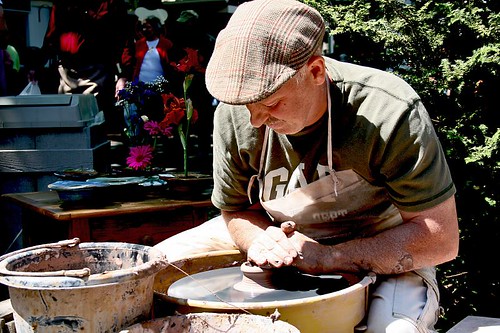There are two men inside the artist, the poet and the craftsman.
One is born a poet.
One becomes a craftsman.
~ Emile Zola
I bought my wife a piece of handcrafted jewellery for Christmas.
The craftsman, in this case a silver smith, had created his own design, rather than copy from somebody else’s idea.
Hand crafted, not mass produced, is a better product don’t you think?
Surely that is why we put a higher value on it?
Then why is it that we spend our professional lives wanting to adopt the latest mass-produced solutions?
This is the final article in the series discussing areas of focus for 2011. Despite being the last post, craft was the first focal word I coined for the year.
A craft is something that falls between an Art (which requires talent) and a Science (which relies on knowledge). Historically it tended to apply to those who engaged in small-scale production.
Crafts also featured a hierarchy of development. One started as an apprentice, assigned to a master craftsman. In this role you learned the craft by actually doing it – rather than simply reading about what was involved in a book. Once the apprenticeship was finished the journeyman started the search for a place to establish himself – eventually establishing his own shop and becoming a master of his craft.
This area of focus includes a number of important dimensions. Firstly it relates to the craft of writing, better written blog posts will hopefully generate comment and discussion.
Secondly there are the aspects of building resilience as being a craft. This brings in the recurring theme of blending Art & Science – and also provides a renewed focus on the practical application aspects.
Part of the concept here is adapted from the Greek – Techne – where the focus is on using the knowledge rather than simply understanding for its own sake. In ancient Greek philosophy a craft is also the practical application of an art, rather than art as an end in itself.
The concept of a craft of resilience is another device to focus on the need to apply this thinking in the real world.
It is also intended to provide additional focus on the way in which we conduct this practice, or apply these arts.
Mass production was designed to create cheaper solutions. It relies on standardised products and offerings, epitomised in the famous quote from a pioneer of mass-production, Henry Ford, that a customer can have his Model-T “painted any colour that he wants so long as it is black”.
Unfortunately this degree of standardisation and low priced solutions leads to the offering becoming a commodity. Commodities can only compete based on price (or cost for the internal deliverable). A solution that has become a commodity cannot be a source of competitive advantage not a strategic differentiator.
This may explain why some Risk/BC folks have difficulty getting Executive Management to pay attention to what they are promoting. A non-strategic, internally-focussed, commodity process.
In the wider economy we are in the Post-Fordist era. Newer approaches take into account concepts like ‘Flexible specialisation’ and ‘mass customisation’.
The focus on resilience as a craft is also to keep reminding me that there is no ‘one size fits all’ approach and that you cannot have a standardised way to build and maintain resilience. We need to learn the skills, techniques and practices of our craft – but the design and application need to be customised to our specific circumstances.
A craftsman does not work from a mass-produced design, nor deliver a cheap, standardised commodity.
Doesn’t that describe this concept of resilience also?
Do you think the concept of craft is helpful?

Leave a Reply